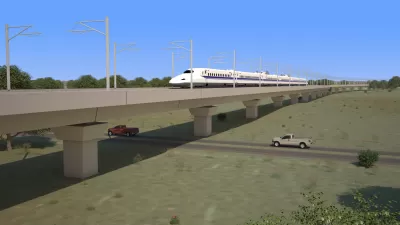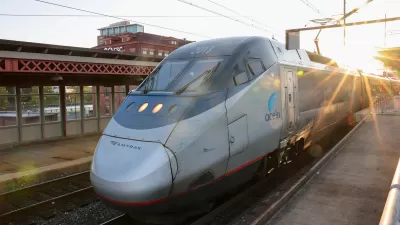Author Tom Vanderbilt suggests that train service has been headed in the wrong direction for the better part of a century.
"There is at least one technology in America...that is worse now than it was in the early 20th century: the train.
I have recently been poring over a number of prewar train timetables-not surprisingly, available on eBay. They are fascinating, filled with evocations of that fabled "golden era" of train travel. "You travel with friends on The Milwaukee Road," reads an ad in one, showing an avuncular conductor genially conversing with a jaunty, smartly dressed couple, the man on the verge of lighting a pipe. The brochure for the Montreal Limited, from an era when "de luxe" was still two words, assures travelers that 'modern air-conditioning scientifically controls temperature, humidity and purity of air at all seasons.'
But the most striking aspect of these antiquated documents is found in the tiny agate columns of arrivals and destinations. It is here that one sees the wheels of progress actually running backward. The aforementioned Montreal Limited, for example, circa 1942, would pull out of New York's Grand Central Station at 11:15 p.m., arriving at Montreal's (now defunct) Windsor Station at 8:25 a.m., a little more than nine hours later. To make that journey today, from New York's Penn Station on the Adirondack, requires a nearly 12-hour ride. The trip from Chicago to Minneapolis via the Olympian Hiawatha in the 1950s took about four and a half hours; today, via Amtrak's Empire Builder, the journey is more than eight hours. Going from Brattleboro, Vt., to New York City on the Boston and Maine Railroad's Washingtonian took less than five hours in 1938; today, Amtrak's Vermonter (the only option) takes six hours-if it's on time, which it isn't, nearly 75 percent of the time."
Thanks to Franny Ritchie
FULL STORY: Stop This Train!Are trains slower now than they were in the 1920s?

Planetizen Federal Action Tracker
A weekly monitor of how Trump’s orders and actions are impacting planners and planning in America.

Congressman Proposes Bill to Rename DC Metro “Trump Train”
The Make Autorail Great Again Act would withhold federal funding to the system until the Washington Metropolitan Area Transit Authority (WMATA), rebrands as the Washington Metropolitan Authority for Greater Access (WMAGA).

DARTSpace Platform Streamlines Dallas TOD Application Process
The Dallas transit agency hopes a shorter permitting timeline will boost transit-oriented development around rail stations.

The Tiny, Adorable $7,000 Car Turning Japan Onto EVs
The single seat Mibot charges from a regular plug in about as much time as an iPad, and is about half the price of an average EV.

Supreme Court Ruling in Pipeline Case Guts Federal Environmental Law
The decision limits the scope of a federal law that mandates extensive environmental impact reviews of energy, infrastructure, and transportation projects.

Texas State Bills to Defund Dallas Transit Die
DART would have seen a 30% service cut, $230M annual losses had the bills survived.
Urban Design for Planners 1: Software Tools
This six-course series explores essential urban design concepts using open source software and equips planners with the tools they need to participate fully in the urban design process.
Planning for Universal Design
Learn the tools for implementing Universal Design in planning regulations.
Roanoke Valley-Alleghany Regional Commission
City of Mt Shasta
City of Camden Redevelopment Agency
City of Astoria
Transportation Research & Education Center (TREC) at Portland State University
US High Speed Rail Association
City of Camden Redevelopment Agency
Municipality of Princeton (NJ)





























